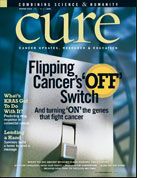Publication
Article
CURE
Non-Hodgkin Lymphoma & Supportive Care
Author(s):
Treanda and Sancuso patch approved.
Less than eight months after the Food and Drug Administration approved Treanda (bendamustine) for chronic lymphocytic leukemia, the drug received its second approval on October 31, this time in slow-growing B-cell non-Hodgkin lymphoma.
The FDA based its decision on a single-arm trial that involved 100 patients who received Treanda for two days every three weeks for up to six months. Initially announced at the American Society of Hematology annual meeting in late 2007, results showed three-quarters of patients experienced a positive response to the drug, with cancer markers decreasing or disappearing. Seventeen patients had a complete response to the drug, meaning no signs or symptoms of the disease were present. The overall response lasted a median of 9.2 months, and progression-free survival reached 9.3 months. Common side effects included nausea, vomiting, anemia, and fatigue.
Although a slow-growing cancer, this type of NHL typically recurs or becomes resistant to standard therapy such as Rituxan (rituximab), so the addition of Treanda comes as welcome news to patients and physicians. The 50-year-old ­chemotherapy is also being tested in early-phase trials for leukemia, myelodysplastic syndromes, and breast cancer.
About 30,000 people will be diagnosed with indolent B-cell NHL this year, according to the National Cancer Institute. For more on Treanda, go to www.treanda.com.
Patients who suffer from chemotherapy-induced nausea and vomiting now have another option to relieve their symptoms. Sancuso (granisetron), which was approved by the Food and Drug Administration in September, is administered as a patch and provides up to five days of relief.
The patch was approved based on results of a phase III study that compared daily granisetron given by mouth versus granisetron delivered via the Sancuso patch. The 641 patients in the trial were on chemotherapy that had a high to moderate risk of nausea and vomiting. Sancuso controlled patients’ symptoms as much as the oral drug and was more convenient to patients, especially those with problems swallowing. The most commonly reported side effect with the patch was constipation.
Several antiemetics are on the market to prevent chemotherapy-induced nausea and vomiting, but the side effect remains one of patients’ top concerns. Sancuso is a 5-HT3 antagonist, a class of drugs that blocks serotonin from binding to 5-HT3 receptors. Some chemotherapy agents trigger a signal to the brain that induces nausea and vomiting. Sancuso and other 5-HT3 inhibitors, such as Zofran (ondansetron) and Aloxi (palonosetron), interrupt that signal.
Read more about management of nausea and vomiting in “Squashing a Queasy Stomach”. For more on Sancuso, visit www.sancuso.com.
The Food and Drug Administration granted accelerated approval of Promacta (eltrombopag) on November 20, making it the first oral drug to treat thrombocytopenia in patients with chronic immune thrombocytopenic purpura (ITP). While ITP is rare in most cancer patients, the approval may lead to the drug being used for thrombocytopenia caused by cancer or chemotherapy. Read more about Promacta in Fall 2008’s “Drugs in the News.”





